二级笔译翻译参考书
2017年下半年11月全国翻译专业考试二级笔译实务真题(含官方参考译文-CATTI考试)
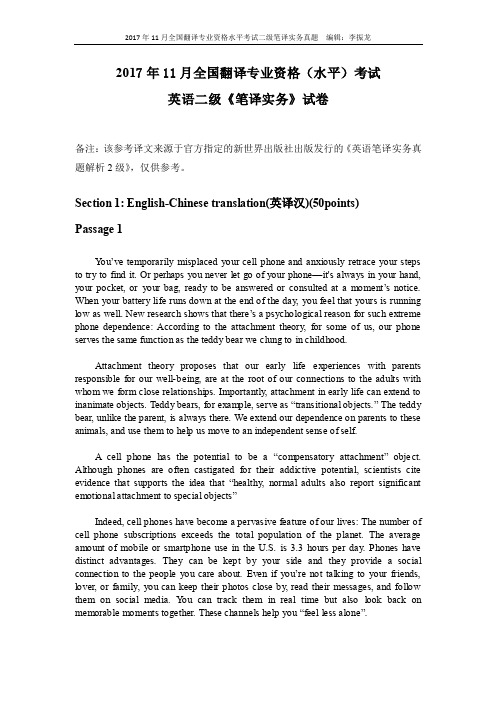
2017年11月全国翻译专业资格(水平)考试英语二级《笔译实务》试卷备注:该参考译文来源于官方指定的新世界出版社出版发行的《英语笔译实务真题解析2级》,仅供参考。
Section 1: English-Chinese translation(英译汉)(50points)Passage 1Y ou’ve temporarily misplaced your cell phone and anxiously retrace your steps to try to find it. Or perhaps you never let go of your phone—it's always in your hand, your pocket, or your bag, ready to be answered or consulted at a moment’s notice. When your battery life runs down at the end of the day, you feel that yours is running low as well. New research s hows that there’s a psychological reason for such extreme phone dependence: According to the attachment theory, for some of us, our phone serves the same function as the teddy bear we clung to in childhood.Attachment theory proposes that our early life experiences with parents responsible for our well-being, are at the root of our connections to the adults with whom we form close relationships. Importantly, attachment in early life can extend to inanimate objects. Teddy bears, for example, serve as “transitional objects.” The teddy bear, unlike the parent, is always there. We extend our dependence on parents to these animals, and use them to help us move to an independent sense of self.A cell phone has the potential to be a “compensatory attachment” obje ct. Although phones are often castigated for their addictive potential, scientists cite evidence that supports the idea that “healthy, normal adults also report significant emotional attachment to special objects”Indeed, cell phones have become a pervasive feature of our lives: The number of cell phone subscriptions exceeds the total population of the planet. The average amount of mobile or smartphone use in the U.S. is 3.3 hours per day. Phones have distinct advantages. They can be kept by your side and they provide a social connection to the people you care about. Even if you’re not talking to your friends, lover, or family, you can keep their photos close by, read their messages, and follow them on social media. Y ou can track them in real time but also look back on memorable moments together. These channels help you “feel less alone”.Passage 2Many countries have adopted the principle of sustainable development it can combat environment deterioration in air quality, water quality and production in developing countries. Health education serves as a viable role for every member in the world. But some argue that it's a vague idea, some organizations may use it in its own interests, whether environmental or economic is the nature of interests. Others argue that sustainable development in developing countries overlook the local customs, habitude and people.Whereas interdependence is desirable during times of peace, war necessitates competition and independence. Tariffs and importation limits strengthen a country's economic vitality while potentially weakening the economies of its enemies. Moreover, protectionism in the weapons industry is highly desirable during such circumstances because reliance on another state for armaments can be fatal.For the most part, economists emphasize the negative effects of protectionism. It reduces international trade and raises prices for consumers. In addition, domestic firms that receive protection have less incentive to innovate. Although free trade puts uncompetitive firms out of business, the displaced workers and resources are ultimately allocated to other areas of the economy.Imposing quotas is a method used to protect trade, since foreign companies cannot ship more products regardless of how low they set their prices. Countries that hope to help a new industry thrive locally often impose quotas on imported goods. They believe that such restrictions allow entities in the new industry to develop their own competitive advantages and produce the products efficiently.Protectionism’s purpose is usually to create jobs for domestic workers. Companies that operate in industries protected by quotas hire workers locally. Another disadvantage of quotas is the reduction in the quality of products in the absence of competition from foreign companies. Without competition, local firms are less likely to invest in innovation and improve their products and services. Domestic sellers don’t have an incentive to enhance efficiency and lower their prices, and under such conditions, consumers eventually pay more for products and services they could receive from foreign competitors. As local companies lose competitiveness, they become pressured to outsource jobs. In the long-run, increasing protectionism commonly leads to layoffs and economic slowdown.Section 2: Chinese-English translation(汉译英)(50points)Passage 1。
2019年CATTI二级笔译英译汉真题及参考答案
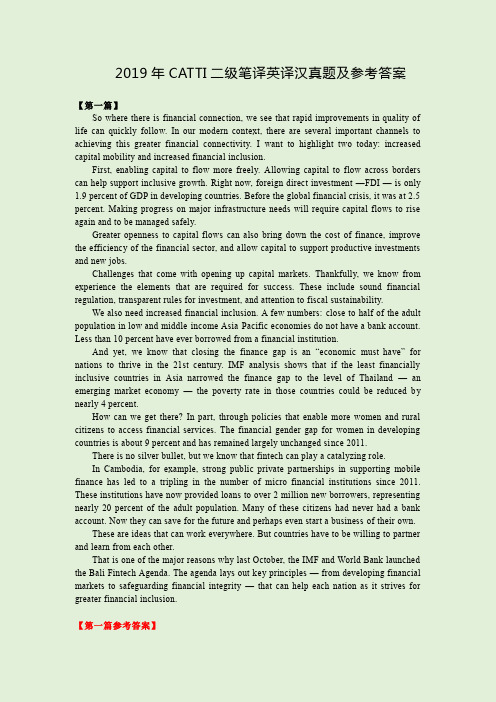
2019年CATTI二级笔译英译汉真题及参考答案【第一篇】So where there is financial connection, we see that rapid improvements in quality of life can quickly follow. In our modern context, there are several important channels to achieving this greater financial connectivity. I want to highlight two today: increased capital mobility and increased financial inclusion.First, enabling capital to flow more freely. Allowing capital to flow across borders can help support inclusive growth. Right now, foreign direct investment —FDI — is only 1.9 percent of GDP in developing countries. Before the global financial crisis, it was at 2.5 percent. Making progress on major infrastructure needs will require capital flows to rise again and to be managed safely.Greater openness to capital flows can also bring down the cost of finance, improve the efficiency of the financial sector, and allow capital to support productive investments and new jobs.Challenges that come with opening up capital markets. Thankfully, we know from experience the elements that are required for success. These include sound financial regulation, transparent rules for investment, and attention to fiscal sustainability.We also need increased financial inclusion. A few numbers: close to half of the adult population in low and middle-income Asia-Pacific economies do not have a bank account. Less than 10 percent have ever borrowed from a financial institution.And yet, we know that closing the finance gap is an “economic must-have” for nations to thrive in the 21st century. IMF analysis shows that if the least financially inclusive countries in Asia narrowed the finance gap to the level of Thailand — an emerging market economy — the poverty rate in those countries could be reduced by nearly 4 percent.How can we get there? In part, through policies that enable more women and rural citizens to access financial services. The financial gender gap for women in developing countries is about 9 percent and has remained largely unchanged since 2011.There is no silver bullet, but we know that fintech can play a catalyzing role.In Cambodia, for example, strong public-private partnerships in supporting mobile finance has led to a tripling in the number of micro-financial institutions since 2011. These institutions have now provided loans to over 2 million new borrowers, representing nearly 20 percent of the adult population. Many of these citizens had never had a bank account. Now they can save for the future and perhaps even start a business of their own.These are ideas that can work everywhere. But countries have to be willing to partner and learn from each other.That is one of the major reasons why last October, the IMF and World Bank launched the Bali Fintech Agenda. The agenda lays out key principles — from developing financial markets to safeguarding financial integrity — that can help each nation as it strives for greater financial inclusion.【第一篇参考答案】哪里形成了金融联系,当地的生活质量就会很快改善。
catti二级笔译备考
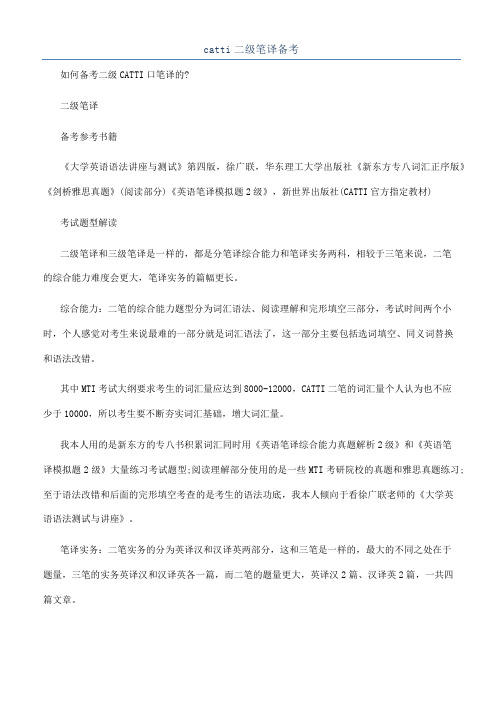
catti二级笔译备考如何备考二级CATTI口笔译的?二级笔译备考参考书籍《大学英语语法讲座与测试》第四版,徐广联,华东理工大学出版社《新东方专八词汇正序版》《剑桥雅思真题》(阅读部分)《英语笔译模拟题2级》,新世界出版社(CATTI官方指定教材)考试题型解读二级笔译和三级笔译是一样的,都是分笔译综合能力和笔译实务两科,相较于三笔来说,二笔的综合能力难度会更大,笔译实务的篇幅更长。
综合能力:二笔的综合能力题型分为词汇语法、阅读理解和完形填空三部分,考试时间两个小时,个人感觉对考生来说最难的一部分就是词汇语法了,这一部分主要包括选词填空、同义词替换和语法改错。
其中MTI考试大纲要求考生的词汇量应达到8000-12000,CATTI二笔的词汇量个人认为也不应少于10000,所以考生要不断夯实词汇基础,增大词汇量。
我本人用的是新东方的专八书积累词汇同时用《英语笔译综合能力真题解析2级》和《英语笔译模拟题2级》大量练习考试题型;阅读理解部分使用的是一些MTI考研院校的真题和雅思真题练习;至于语法改错和后面的完形填空考查的是考生的语法功底,我本人倾向于看徐广联老师的《大学英语语法测试与讲座》。
笔译实务:二笔实务的分为英译汉和汉译英两部分,这和三笔是一样的,最大的不同之处在于题量,三笔的实务英译汉和汉译英各一篇,而二笔的题量更大,英译汉2篇、汉译英2篇,一共四篇文章。
在这里,我分享一个观点:曾经有一位一笔老师来我们学校讲座时说过这么一个观点,我们做的英译汉的译文最好的就是把我们的译文拿给另一个人看,如果我们的读者能无压力地看懂的话,说明我们的译文才是合格的。
我认为这位老师的观点我很认同。
结合一下我的实际情况补充一个观点:就是我们在遇到专业性较强的文章时,我们翻译出来的译文要给专业的人给我们当读者。
我平常在英译汉练习时碰到一些专业性较强的英文文章,比如我曾经翻译过的一期《经济学人》里提及过经济学的概念,“二八定律”(80/20rule),文章后面写到了“80%的收入都来自销售额居前5位的产品”,如果译者对“二八定律”内涵很熟悉的话会马上想到这个经济学名词,否则我们的译文就会花样百出,十分精彩。
2023年11月英语二级笔译英译汉参考答案
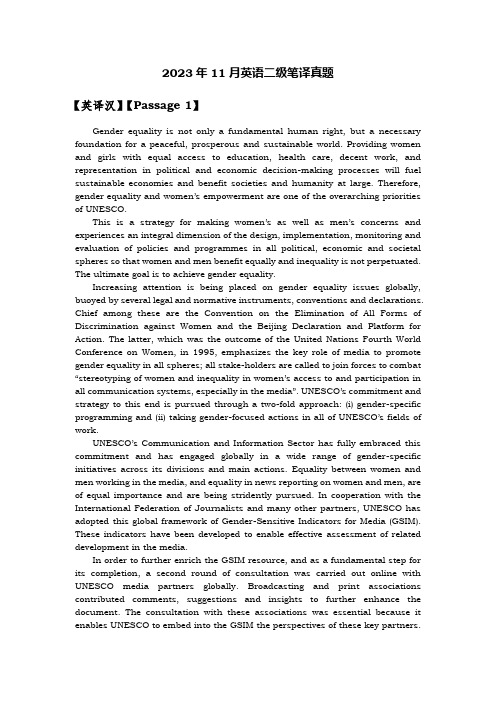
2023年11月英语二级笔译真题【英译汉】【Passage 1】Gender equality is not only a fundamental human right, but a necessary foundation for a peaceful, prosperous and sustainable world. Providing women and girls with equal access to education, health care, decent work, and representation in political and economic decision-making processes will fuel sustainable economies and benefit societies and humanity at large. Therefore, gender equality and women’s empowerment are one of the overarching priorities of UNESCO.This is a st rategy for making women’s as well as men’s concerns and experiences an integral dimension of the design, implementation, monitoring and evaluation of policies and programmes in all political, economic and societal spheres so that women and men benefit equally and inequality is not perpetuated. The ultimate goal is to achieve gender equality.Increasing attention is being placed on gender equality issues globally, buoyed by several legal and normative instruments, conventions and declarations. Chief among these are the Convention on the Elimination of All Forms of Discrimination against Women and the Beijing Declaration and Platform for Action. The latter, which was the outcome of the United Nations Fourth World Conference on Women, in 1995, emphasizes the key role of media to promote gender equality in all spheres; all stake-holders are called to join forces to combat “stereotyping of women and inequality in women’s access to and participation in all communication systems, especially in the media”. UNESCO’s c ommitment and strategy to this end is pursued through a two-fold approach: (i) gender-specific programming and (ii) taking gender-focused actions in all of UNESCO’s fields of work.UNESCO’s Communication and Information Sector has fully embraced this commitment and has engaged globally in a wide range of gender-specific initiatives across its divisions and main actions. Equality between women and men working in the media, and equality in news reporting on women and men, are of equal importance and are being stridently pursued. In cooperation with the International Federation of Journalists and many other partners, UNESCO has adopted this global framework of Gender-Sensitive Indicators for Media (GSIM). These indicators have been developed to enable effective assessment of related development in the media.In order to further enrich the GSIM resource, and as a fundamental step for its completion, a second round of consultation was carried out online with UNESCO media partners globally. Broadcasting and print associations contributed comments, suggestions and insights to further enhance the document. The consultation with these associations was essential because it enables UNESCO to embed into the GSIM the perspectives of these key partners.This enables us to stress that use of the GSIM is not an attempt to limit freedom of expression and the independence of media, but to voluntarily enrich these underlying characteristics. UNESCO is confident that, if fully implemented, the GSIM will produce an impact in both qualitative and quantitative terms.【英译汉】【Passage 2】When rainfall is measured in feet, not inches, we are witnessing climate change bearing down on us. Catastrophic destruction tied to the Atlantic hurricane season, monsoon rains in Mumbai, and downpours in Niger are just a few of the many extreme weather events that are being intensified by global warming. While the rise of a few degrees in temperature may not be enough for a person to run a fever, that change is enough to radically impact the earth’s climate. By way of comparison, the earth was once rendered largely uninhabitable by a one to two-degree Celsius drop in temperature—an era now referred to as the Little Ice Age. In response to the threat posed by global climate change, most nations have committed to significant mitigation efforts, through the Paris Agreement, to reduce greenhouse gas emissions.But will these collective efforts be enough? Some scientists are trying another approach, exploring new tools to deliberately alter the global climate system. These discrete and diverse technologies are often grouped under the all-encompassing and poorly defined rubric of “climate engineering” or “geoengineering.” These radically different approaches aim to either halt the process of global warming by removing greenhouse gases from the atmosphere or to counteract warming already underway.The problem is, while several tools seem to be gaining ground in computer models, laboratories, and even real-world experiments, public discussion has not kept pace with their advancement. To date, there has been too little transparency and international dialogue around the progress, feasibility, risks and benefits of these efforts. Climate engineering and current mitigation and adaptation efforts are not mutually exclusive. Experts generally agree that these new technological approaches alone are unlikely to provide adequate protection from the dangers posed by rising global temperatures.In 1965, the Science Advisory Committee raised concerns about manmade climate change and warned that “man is unwittingly conducting a vast geophysical experiment.” More than 50 years later, the field of climate engineering remains largely unknown, especially to policymakers and the public.There are real risks to using or rejecting climate engineering. While it is tempting to be for or against climate engineering, what decision-makers need to do now is to gather scientific facts and ask as many questions as possible about what the deployment of these technologies might mean for individuals, societies, nations, and regions.2023年11月英语二级笔译真题参考答案【英译汉】【Passage 1】性别平等不仅是一项基本的人权,也是建设一个和平、繁荣、可持续的世界所必需的基础。
二级笔译翻译参考书
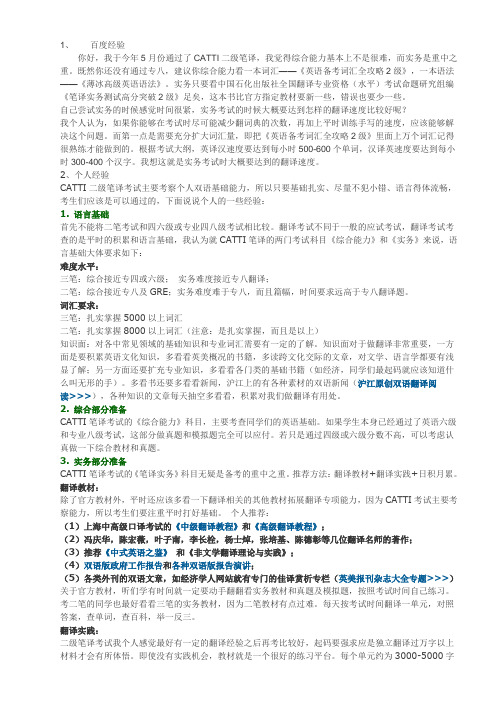
1、百度经验你好,我于今年5月份通过了CATTI二级笔译,我觉得综合能力基本上不是很难,而实务是重中之重。
既然你还没有通过专八,建议你综合能力看一本词汇——《英语备考词汇全攻略2级》,一本语法——《薄冰高级英语语法》。
实务只要看中国石化出版社全国翻译专业资格(水平)考试命题研究组编《笔译实务测试高分突破2级》足矣,这本书比官方指定教材要新一些,错误也要少一些。
自己尝试实务的时候感觉时间很紧,实务考试的时候大概要达到怎样的翻译速度比较好呢?我个人认为,如果你能够在考试时尽可能减少翻词典的次数,再加上平时训练手写的速度,应该能够解决这个问题。
而第一点是需要充分扩大词汇量,即把《英语备考词汇全攻略2级》里面上万个词汇记得很熟练才能做到的。
根据考试大纲,英译汉速度要达到每小时500-600个单词,汉译英速度要达到每小时300-400个汉字。
我想这就是实务考试时大概要达到的翻译速度。
2、个人经验CATTI二级笔译考试主要考察个人双语基础能力,所以只要基础扎实、尽量不犯小错、语言得体流畅,考生们应该是可以通过的,下面说说个人的一些经验:1. 语言基础首先不能将二笔考试和四六级或专业四八级考试相比较。
翻译考试不同于一般的应试考试,翻译考试考查的是平时的积累和语言基础,我认为就CATTI笔译的两门考试科目《综合能力》和《实务》来说,语言基础大体要求如下:难度水平:三笔:综合接近专四或六级;实务难度接近专八翻译;二笔:综合接近专八及GRE;实务难度难于专八,而且篇幅,时间要求远高于专八翻译题。
词汇要求:三笔:扎实掌握5000以上词汇二笔:扎实掌握8000以上词汇(注意:是扎实掌握,而且是以上)知识面:对各中常见领域的基础知识和专业词汇需要有一定的了解。
知识面对于做翻译非常重要,一方面是要积累英语文化知识,多看看英美概况的书籍,多读跨文化交际的文章,对文学、语言学都要有浅显了解;另一方面还要扩充专业知识,多看看各门类的基础书籍(如经济,同学们最起码就应该知道什么叫无形的手)。
全国翻译专业资格(水平)考试英语二级笔译实务历年真题(2016-2018年含官方参考译文CATTI)
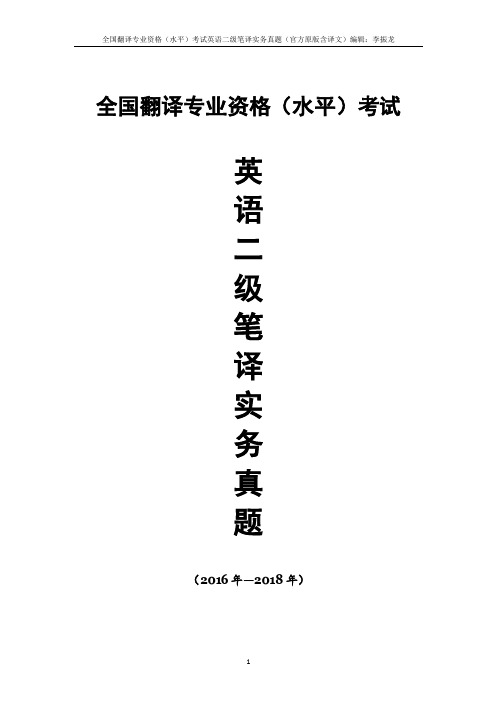
笔者 2019 年 7 月 2 日
3
全国翻译专业资格(水平)考试英语二级笔译实务真题(官方原版含译文)编辑:李振龙
2018 年 11 月全国翻译专业资格(水平)考试
英语二级《笔译实务》试卷
Section1:English-Chinesetranslation(英译汉)(50points)
2
全国翻译专业资格(水平)考试英语二级笔译实务真题(官方原版含译文)编辑:李振龙
编辑说明
《全国翻译专业资格(水平)考试》是全国实行统一、面向社会的、国内最 具权威的翻译专业资格考试(认证),是对参试人员口译或笔译方面双语互译能 力和水平的认定。截止 2019 年之前官方(中国外文局)从未公布历年考试真题, 2019 年 4 月首次公布真题,但由于定价太高,且网络虽散见历年回忆版试题, 但并不完整,且错误较多,不利于考生复习备考。故笔者收集整理校对近三年《二 级笔译实务》真题,供广大参加翻译专业考试人员参考使用。
Passage 1
New drone footage gives a glimpse of the damage that parts of Hawaii's Big Island sustained in the wake of volcanic explosions in recent days. Smoke can be seen billowing off the lava as it creeps down roads and through wooded areas toward homes. Fires are visible with terrifying streams of brightness breaking through the surrounding areas of black. After a day of relative calm, Kilauea roared back in full force on Sunday, spewing lava 3,00 feet in the air, encroaching on a half mile of new ground and bringing the total number of destroyed structures to 35.
人事部翻译考试(二级)系列参考资料(1)
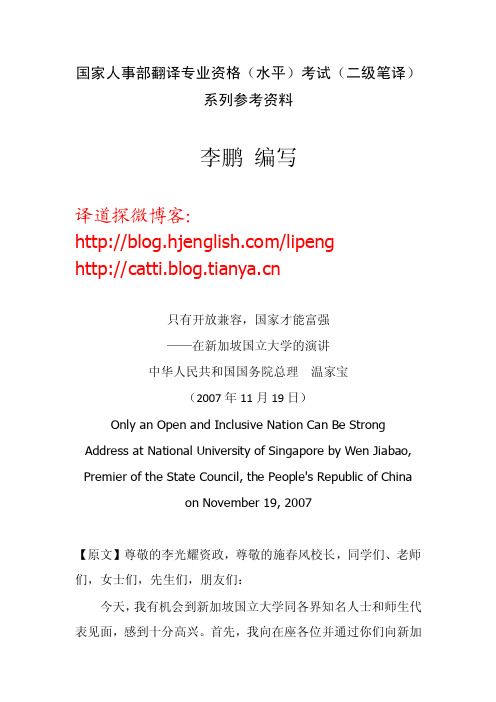
国家人事部翻译专业资格(水平)考试(二级笔译)系列参考资料李鹏编写译道探微博客:/lipeng只有开放兼容,国家才能富强——在新加坡国立大学的演讲中华人民共和国国务院总理温家宝(2007年11月19日)Only an Open and Inclusive Nation Can Be Strong Address at National University of Singapore by Wen Jiabao, Premier of the State Council, the People's Republic of Chinaon November 19, 2007【原文】尊敬的李光耀资政,尊敬的施春风校长,同学们、老师们,女士们,先生们,朋友们:今天,我有机会到新加坡国立大学同各界知名人士和师生代表见面,感到十分高兴。
首先,我向在座各位并通过你们向新加坡人民转达中国人民的诚挚问候和良好祝愿。
【译文】Minister Mentor Lee Kuan Yew,Mr. Shih Choon Fong, President of the National University of Singapore,Students and faculty members,Ladies and gentlemen,Friends,I am delighted to have this opportunity of meeting you, leading public figures in Singapore and representatives of faculty and students of the National University of Singapore (NUS). Let me begin by conveying the warm greetings and best wishes of the Chinese people to you, and through you, to the people of Singapore.【评点】1.第二部分值得背诵,口译和笔译工作中都能用得上。
2021年11月CATTI二级笔译真题
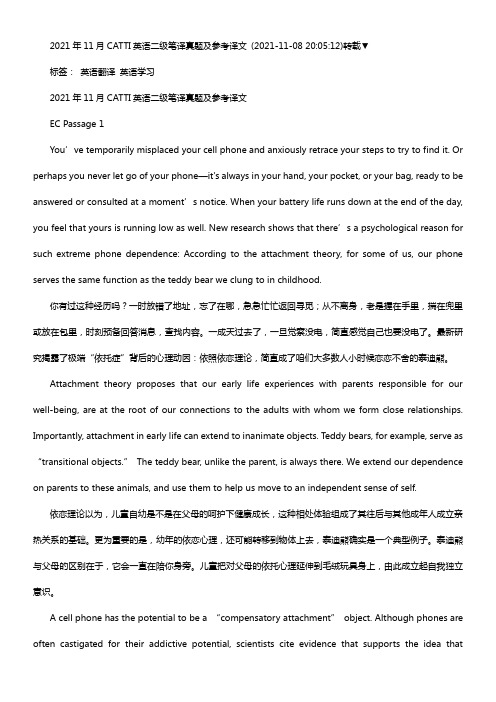
2021年11月CATTI英语二级笔译真题及参考译文(2021-11-08 20:05:12)转载▼标签:英语翻译英语学习2021年11月CATTI英语二级笔译真题及参考译文EC Passage 1You’ve temporarily misplaced your cell phone and anxiously retrace your steps to try to find it. Or perhaps you never let go of your phone—it's always in your hand, your pocket, or your bag, ready to be answered or consulted at a moment’s notice. When your battery life runs down at the end of the day, you feel that yours is running low as well. New research shows that there’s a psychological reason for such extreme phone dependence: According to the attachment theory, for some of us, our phone serves the same function as the teddy bear we clung to in childhood.你有过这种经历吗?一时放错了地址,忘了在哪,急急忙忙返回寻觅;从不离身,老是握在手里,揣在兜里或放在包里,时刻预备回答消息,查找内容。
一成天过去了,一旦觉察没电,简直感觉自己也要没电了。
最新研究揭露了极端“依托症”背后的心理动因:依照依恋理论,简直成了咱们大多数人小时候恋恋不舍的泰迪熊。
- 1、下载文档前请自行甄别文档内容的完整性,平台不提供额外的编辑、内容补充、找答案等附加服务。
- 2、"仅部分预览"的文档,不可在线预览部分如存在完整性等问题,可反馈申请退款(可完整预览的文档不适用该条件!)。
- 3、如文档侵犯您的权益,请联系客服反馈,我们会尽快为您处理(人工客服工作时间:9:00-18:30)。
1、百度经验
你好,我于今年5月份通过了CATTI二级笔译,我觉得综合能力基本上不是很难,而实务是重中之重。
既然你还没有通过专八,建议你综合能力看一本词汇——《英语备考词汇全攻略2级》,一本语法——《薄冰高级英语语法》。
实务只要看中国石化出版社全国翻译专业资格(水平)考试命题研究组编《笔译实务测试高分突破2级》足矣,这本书比官方指定教材要新一些,错误也要少一些。
自己尝试实务的时候感觉时间很紧,实务考试的时候大概要达到怎样的翻译速度比较好呢?
我个人认为,如果你能够在考试时尽可能减少翻词典的次数,再加上平时训练手写的速度,应该能够解决这个问题。
而第一点是需要充分扩大词汇量,即把《英语备考词汇全攻略2级》里面上万个词汇记得很熟练才能做到的。
根据考试大纲,英译汉速度要达到每小时500-600个单词,汉译英速度要达到每小时300-400个汉字。
我想这就是实务考试时大概要达到的翻译速度。
2、个人经验
CATTI二级笔译考试主要考察个人双语基础能力,所以只要基础扎实、尽量不犯小错、语言得体流畅,考生们应该是可以通过的,下面说说个人的一些经验:
1. 语言基础
首先不能将二笔考试和四六级或专业四八级考试相比较。
翻译考试不同于一般的应试考试,翻译考试考查的是平时的积累和语言基础,我认为就CATTI笔译的两门考试科目《综合能力》和《实务》来说,语言基础大体要求如下:
难度水平:
三笔:综合接近专四或六级;实务难度接近专八翻译;
二笔:综合接近专八及GRE;实务难度难于专八,而且篇幅,时间要求远高于专八翻译题。
词汇要求:
三笔:扎实掌握5000以上词汇
二笔:扎实掌握8000以上词汇(注意:是扎实掌握,而且是以上)
知识面:对各中常见领域的基础知识和专业词汇需要有一定的了解。
知识面对于做翻译非常重要,一方面是要积累英语文化知识,多看看英美概况的书籍,多读跨文化交际的文章,对文学、语言学都要有浅显了解;另一方面还要扩充专业知识,多看看各门类的基础书籍(如经济,同学们最起码就应该知道什么叫无形的手)。
多看书还要多看看新闻,沪江上的有各种素材的双语新闻(沪江原创双语翻译阅读>>>),各种知识的文章每天抽空多看看,积累对我们做翻译有用处。
2. 综合部分准备
CATTI笔译考试的《综合能力》科目,主要考查同学们的英语基础。
如果学生本身已经通过了英语六级和专业八级考试,这部分做真题和模拟题完全可以应付。
若只是通过四级或六级分数不高,可以考虑认真做一下综合教材和真题。
3. 实务部分准备
CATTI笔译考试的《笔译实务》科目无疑是备考的重中之重。
推荐方法:翻译教材+翻译实践+日积月累。
翻译教材:
除了官方教材外,平时还应该多看一下翻译相关的其他教材拓展翻译专项能力,因为CATTI考试主要考察能力,所以考生们要注重平时打好基础。
个人推荐:
(1)上海中高级口译考试的《中级翻译教程》和《高级翻译教程》;
(2)冯庆华,陈宏薇,叶子南,李长栓,杨士焯,张培基、陈德彰等几位翻译名师的著作;
(3)推荐《中式英语之鉴》和《非文学翻译理论与实践》;
(4)双语版政府工作报告和各种双语版报告演讲;
(5)各类外刊的双语文章,如经济学人网站就有专门的佳译赏析专栏(英美报刊杂志大全专题>>>)关于官方教材,听们学有时间就一定要动手翻翻看实务教材和真题及模拟题,按照考试时间自己练习。
考二笔的同学也最好看看三笔的实务教材,因为二笔教材有点过难。
每天按考试时间翻译一单元,对照答案,查单词,查百科,举一反三。
翻译实践:
二级笔译考试我个人感觉最好有一定的翻译经验之后再考比较好,起码要强求应是独立翻译过万字以上材料才会有所体悟。
即使没有实践机会,教材就是一个很好的练习平台。
每个单元约为3000-5000字
的训练量,十几个单元的实务教材加上配套辅导,再配合自己平时看的双语新闻、政府工作报告、各类翻译材料,达到十万字的翻译量也是不难的。
如果能坚持一天一单元按考试时间做完成三笔的实务教材和二笔实务教材,加上平时各类翻译教材和一定的实践经验,几十万字的翻译经验坚持下来应对二级笔译考试已经足够,所以大家一定要真正动手去翻译练习。
日积月累:
平时要多看看各类原版的百科书,只有感兴趣的都行。
多看外刊注重平时的语言沉淀和地道的表达,这样考试才能临危不乱,毕竟CATTI考试还是重在平时积累。
4. 考试注意事项
各省市人事部网站都会出报名通知,CATTI考试的官网也有通知,每年报名为上半年1-3月,下半年7-9月,各地根据情况报名时间会有所不同,请大家注意。
笔译考试可以带两本字典,英译汉推荐陆谷孙的《英汉大词典》,汉译英推荐外研社的《新世纪汉英大词典》。
书
一本词汇——《英语备考词汇全攻略2级》,
一本语法——《薄冰高级英语语法》。
实务只要看中国石化出版社全国翻译专业资格(水平)考试命题研究组编《笔译实务测试高分突破2级》上海中高级口译考试的《中级翻译教程》和《高级翻译教程》
《中式英语之鉴》和《非文学翻译理论与实践》
3、从网上摘录的
当然要想练好笔译这一真功夫,了解这些还只是前提,必须重视英语词汇积累和写作技能训练,尽可能地提高自己的实际翻译能力。
结合自己的摸索、他人的经验、老师的教导,总结如下一些心得体会:
1、对于一门语言,要有良好的语感,兴趣是最好的开始,这样才能熬过一个枯燥的过程。
培养语感和兴趣的方法很多,也可以很轻松,例如看电影、读书、读小说等。
2、翻译是分专业的,不是一个会语言的人就能够做好任一行业的翻译,要深入到这个行业,了解行业的上游、阶段、终端的知识,对翻译很有用,掌握行业术语,尤其是技术性翻译,不了解的话,自己翻译出来之后自己都看不懂,外国人更无法看懂。
3、选择好行业,最好是自己喜欢的,但有很多时候是被迫的,看机遇和自己的水平了。
4、要有足够的词汇量,这样才能让你游刃有余,否则很难长进,俞敏洪就是一个例子,掌握了7、8万词汇,还有什么东西能难住呢。
5、娴熟的语法知识。
这个重点在笔译的时候会有充分的证明,熟练的语法知识让你能够保证句子结构的准确性和完整性,这点我们都要下功夫。
6、实践的机会。
要抓住每次能够锻炼的机会,成长也就是在这样的磨练下获得的,怕丢脸,那就不要让语言进步了,做与不做全在自己。
每个行业的难度不同,经贸行业相对简单,技术性较强的行业需要投入到更多的时间和训练的机会。
一般情况下,3-8年的磨练会成为专家和高手,这取决于个人的努力。
7、坚持。
高手的练成需要坚持与毅力。
如同长跑,很多人坚持不下去,所以语言学不好,坚持下去了就是对自己的突破,就是成功的开始。
8、专业的限制。
语言是交流的工具,不是只有学语言的同志们才能从事,非语言专业的只能看着。
有很多优秀的翻译确是非语言专业的,应该看到优势的一点,非语言专业对行业的理解力更强些,不会只局限于语言。
对翻译内容的理解更为有深度,这是优势,劣势当然也很明显,这需要翻译自己去弥补。
9、多阅读,多积累。
只有知识量足够大,才能在翻译时将知识信手拈来。
优秀翻译的训练,如同习武,非一朝一夕能够练就。
需要努力、实践、努力、实践这样一个成长的过程。
参加了这次考试我反思了很多,不够努力就要用心。
在有限的时间内激发体内的潜能,这个我们每个人都要做的。
心中格局的建立决定了我们人生的高度,决定了我们水平的高度。
笔译之路任重而道远,我相信我会一直走下去。
曾国藩曾说:“吾辈读书,一者进德之事,讲求诚正修齐之道,以图无忝所生;一者修业之事,操习乎记诵词章之术,以图自卫其身。
”
英语对于我来说就曾大人提到的这两方面均有涉及,于情于理,终有一日我若为鱼她便为水。
